
If it's always been a dream of yours to shift around graphs and points on the $x$ and $y$ axes (and why not?), then you are in luck! Points, graphs, and shapes can be manipulated in the coordinate plane to your heart's content. Want to scoot that triangle a little to the left? Flip it? Spin it? With reflections, rotations, and translations, a lot is possible.
This will be your complete guide to rotations, reflections, and translations of points, shapes, and graphs on the SAT—what these terms mean, the types of questions you'll see on the test, and the tips and formulas you'll need to solve these questions in no time.
Before You Continue
Reflection, rotation, and translation problems are extremely rare on the SAT. If you're aiming for a perfect score (or nearly) and want to grab every last point you can, then this is the guide for you.
But if you still need to brush up on your fundamentals, then your time and energy is better spent studying the more common types of math problems you'll see on the test.
Remember, each question is worth the same amount of points, so it is better that you can answer two or three questions on integers, triangles, or slopes than to answer one question on rotations.
So if you've got everything else nailed down tight (or you just really, really like coordinate geometry), then lets talk reflections, rotations, and translations!
What is a Reflection?
Just like how your image is reflected in a mirror, a graph or a flat (planar) object can be reflected in the coordinate plane. It can be reflected across the x-axis, the y-axis, or any other line, invisible or otherwise. This line, about which the object is reflected, is called the "line of symmetry."
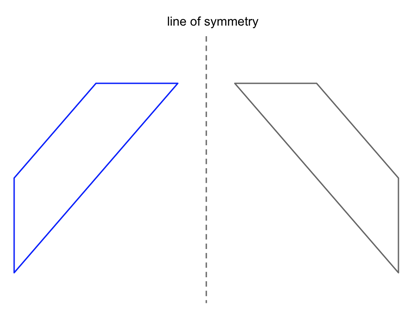
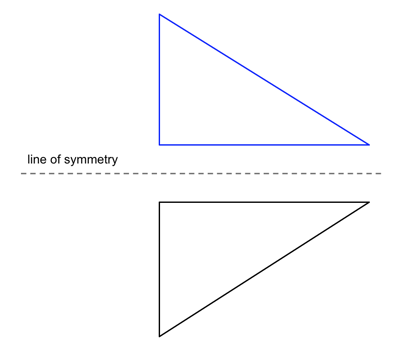
Most SAT reflection questions will ask you to identify a shape that is symmetrical about a line that you must imagine or draw yourself. These questions should be simple enough so long as you pay attention to the details.
For example,
The diagram below shows the Greek letter pi.

Each side of the figure is reflected identically about a vertical line of symmetry. Of the letters shows bellow, which has both a vertical and a horizontal line of symmetry?
A.

B.
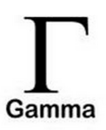
C.
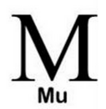
D.

E.

Now, we are being asked for a letter that has BOTH a vertical AND a horizontal line of symmetry (even though the example, pi, only has a vertical line of symmetry). If you are going too quickly through the test, you might be tempted to find the letter with only a vertical line of symmetry like the example picture. Doing this, however, would lead you to select the wrong answer choice.
So, now that we know that we must find a letter that is symmetrical both vertically and horizontally, let us examine our options.
You can either draw lines of reflection in your mind or on the page, but we will draw it out here.
Let us test our options by first giving them a vertical line of symmetry. If they fail the vertical test, then they will automatically be eliminated, with no need to test if they have a horizontal line of symmetry. (Remember, we are looking for a letter that has both.)
So let us draw a potential vertical line of symmetry through each of our answer choices, starting with answer choice A.

We can see that rho does not have a vertical line of symmetry, as each half is not a perfect reflection of one another. We can eliminate answer choice A.

Each half of gamma is also not symmetrical with the other half. We can eliminate answer choice B.

Mu is symmetrical about itself vertically and if you were going quickly through the test, you may be tempted to stop here. But we know we must also find a horizontal line of symmetry.

Mu does not have a horizontal line of symmetry, so we can now eliminate answer choice C.

Eta, as well, has a vertical line of symmetry. Let us see if it also has a horizontal one as well.

Success! Eta is symmetrical, whether the line of symmetry is vertical or horizontal. We can stop here, as we have found our correct answer choice.
Our final answer is D.
 Nature showing off its coordinate geometry skills. Clearly.
Nature showing off its coordinate geometry skills. Clearly.
What is a Rotation?
Objects in the coordinate plane can also be rotated (turned) clockwise or counterclockwise. Imagine that we can adjust the object with our hands—it will spin, while still lying flat, like a piece of paper on a tabletop.
To rotate an object, we must pick a point to act as the center point for our rotation. This center point of our rotation does NOT have to be the center of the shape, however; there must always be a center to our rotation, but we can pick any point to act as this center.
Let us look at a visual demonstration of this.
First, let's look at a shape that has a center of rotation at the center of the shape itself.
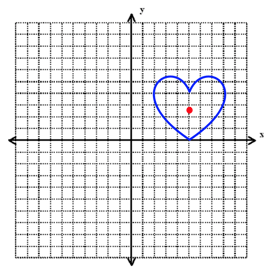

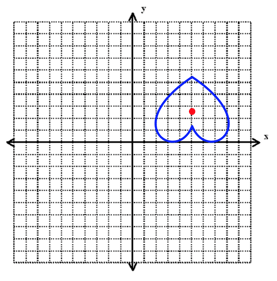
Now we can see how the movement of the object changes as the center of rotation shifts. Here, we have a center of rotation as a point on the outline of the shape.
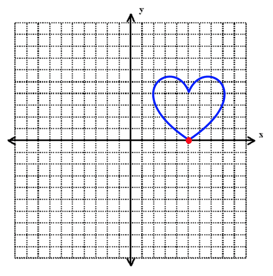

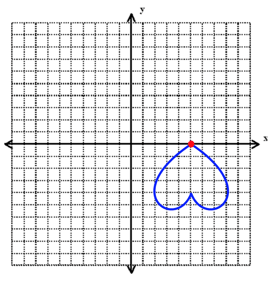
But though any point can act as a center of rotation, you will almost always be asked to rotate an object "about the origin." This means that the origin (coordinates $(0,0)$) will act as your center of rotation.

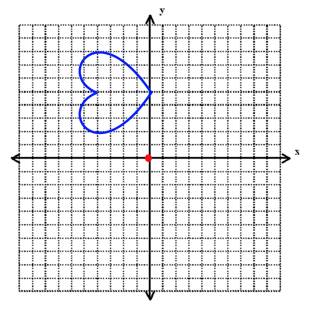
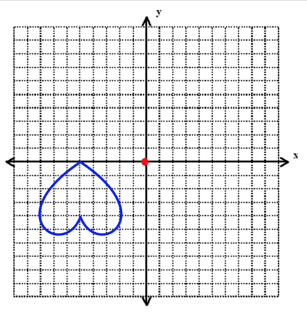
The angle about which the object moves is called the angle of rotation. As we rotate an object, the angle of rotation will be:
- Positive when we move the object counterclockwise
- Negative when the object is rotating clockwise.
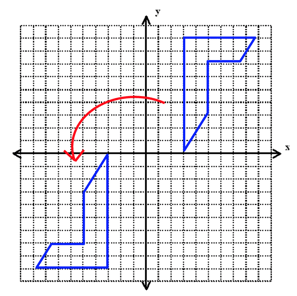
A positive angle of rotation.

A negative angle of rotation.
Through both objects ended up in the same place, one was rotated +180° and the other was rotated -180°.
If you are asked to rotate an object on the SAT, it will be at an angle of 90 degrees or 180 degrees (or, more rarely, 270 degrees). These are nice numbers that evenly divide the coordinate plane into 4 parts, and each of these degree measures has a standard rule of rotation.
Let us look at these rotation rules.
Note: if you're a little shaky on the different quadrants of the $xy$-coordinate plane and where $x$ and $y$ are positive and negative, you should take a couple of minutes to read through our article on the four graph quadrants before going to the next section of this guide.
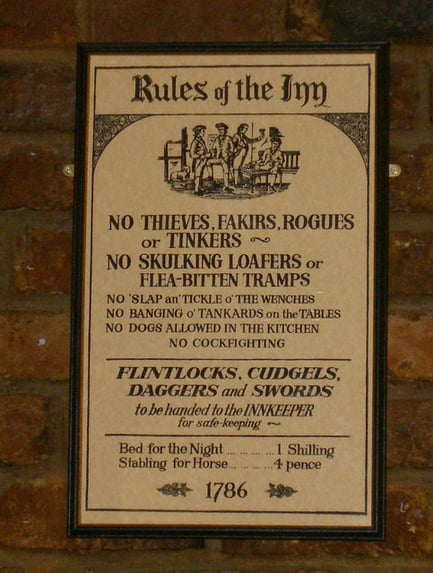
Put your cudgels away and we'll prove we're not fakirs.
Rotation Rules and Formulas
You can determine the new coordinates of your point if you rotate your object by a certain angle about the origin. [Note: these formulas only work when rotating a point or a series of points about the origin—they will not work if rotating the object about any other center of rotation.]
Each of the three degree measures—90, 180, or 270—will shift the coordinates of your original point to a different, calculable, position on the graph. If rotating counterclockwise (a positive angle of rotation), you can use these rules to find your new coordinate points.
For example, let us start with a set of coordinates at $(4, 6)$ and rotate the point.
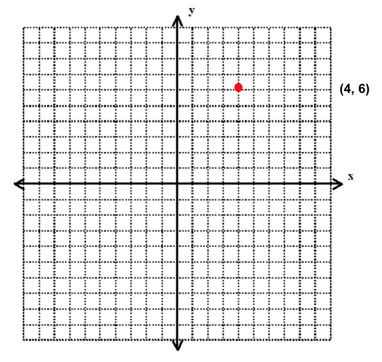
Here we have our original coordinates of $(4, 6)$
For 90 degree rotations:
$(a, b)$ => $(-b, a)$
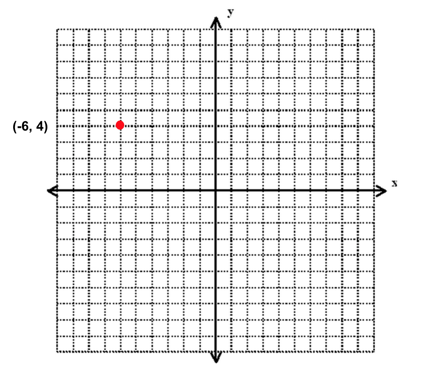
If our original coordinates of (4, 6) are rotated 90°, the new coordinates will be (-6, 4).
For 180 degree rotations:
$(a, b)$ => $(-a, -b)$
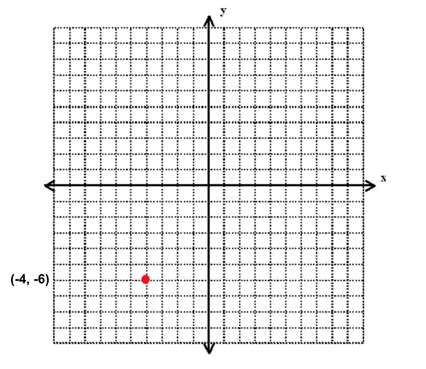
If our original coordinates of $(4, 6)$ are rotated 180°, the new coordinates will be $(-4, -6)$.
For 270 degree rotations:
$(a, b)$ => $(b, -a)$

If our original coordinates of $(4, 6)$ are rotated 270°, the new coordinates will be $(6, -4)$.
(And, of course, a 360 degree rotation will bring you right back to the beginning at $(a, b)$ again!)

If our original coordinates of $(4, 6)$ are rotated 360°, the new coordinates will be the same, $(4, 6)$.
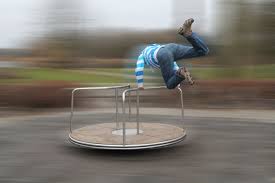
♪ You spin me right round, baby, right round ♪
What is a Translation?
If we continue to think of the shape as a piece of paper lying flat on a table (on the coordinate plane), a translation is the act of sliding it along the coordinate plane in a particular direction.
The shape can be translated up or down (or both!) any amount of distance along the plane. It maintains its shape and bearing, but is simply located elsewhere in the plane.
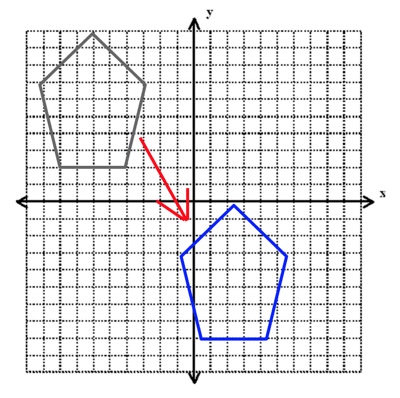
The way to notate that a translation is to occur is by saying:
$T_{a,b}(x,y)$
This means that your final coordinates for this point will be:
$(x + a, y + b)$
For example,
What is the new point for $T_{-3, 4}(2, -6)$?
A. $(-5, 10)$
B. $(-1, 2)$
C. $(1, -2)$
D. $(-5, -10)$
E. $(-1, -2)$
We know that we must add together our translated points to the corresponding $x$ and $y$ values of our original coordinates. So:
$T_{-3, 4}(2, -6)$
$(2 + -3, -6 +4)$
$(-1, -2)$
Our new coordinates for this point are at $(-1, -2)$.
You can see why this is true if we look at it on a graph.
We are starting at the coordinates $(2, -6)$.

Now, we are traveling -3 spaces along the $x$-axis and +4 spaces along the $y$-axis. By tracing this, we can find our new coordinates.
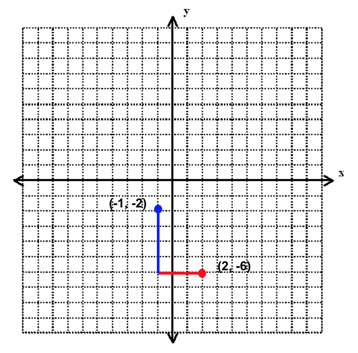
Our final answer is E, $(-1, -2)$.
Typical Reflection, Rotation, and Translation Problems
Again, these types of questions are extremely rare on the SAT, and the odds likely that you will not see any reflection, rotation, or translation problems at all on your test.
That said, there are three different types of reflection/rotation/translation problems that will show up, when they appear at all. These questions will be either a reflection, rotation, or translation questions about:
#1: Points
#2: Shapes in the coordinate plane
#3: Function graphs
Let's look at all three.
Points
Points are the simplest objects to be rotated, reflected, or translated, because there is only one component—the single point. Any point on the coordinate plane will have an $x$-coordinate and a $y$-coordinate, but you will still have far fewer moving parts when dealing with a point rotation than with any other kind of rotation, reflection, or translation.
Shapes
Shapes are slightly more complicated to reflect or rotate than points are for the sheer reason that shapes are made up of several points (and the lines connecting those points). This means that any shape rotation/reflection/translation will require more consideration and care, in order to make sure all your pieces are properly aligned.
It is often much easier, when working with modified shapes, to map out the positions of the points alone. Don't worry about the lines—mark the proper position of the new coordinates for the points and the lines will sort themselves out.
For instance, let us say that we must rotate a trapezoid +90 degrees. The particular question may ask you to find the slope of one of the new lines of the rotated shape, identify a new coordinate point, or anything else. But first, we must rotate our figure.

The easiest way to do this is to simply map the new coordinate points according to our rotating rules. We know that a 90 degree rotation will transform all of our coordinates from $(a, b)$ to $(-b, a)$, so let's find them.
Each given coordinate point will transform like so:
$(1, 1)$ => $(-1, 1)$
$(3, 4)$ => $(-4, 3)$
$(7, 4)$ => $(-4, 7)$
$(9, 1)$ => $(-1, 9)$
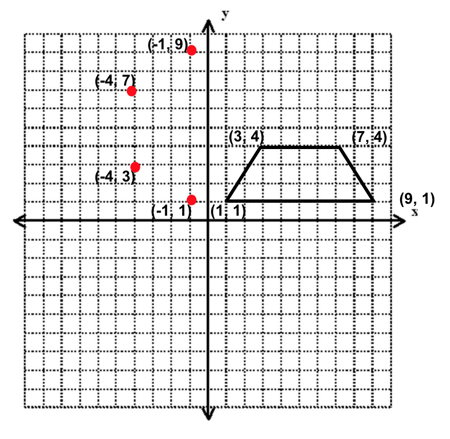
Now we can simply connect the lines and find our new trapezoid, allowing us to answer any question we need to about it.
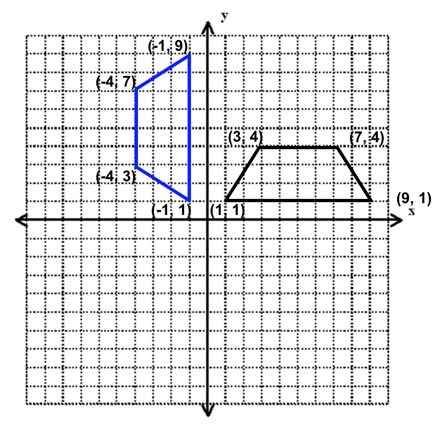
Function Graphs
Finally, function graphs can be reflected or translated just like shapes and points, though NOT rotated. (Why can't functions be rotated? If a function were rotated, it would fail the vertical line test and no longer be a function.)
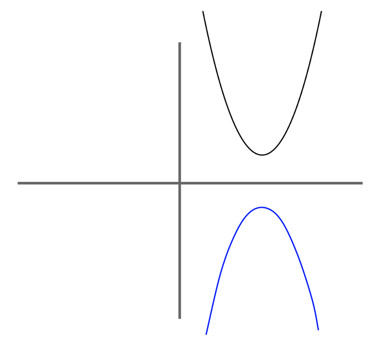
A reflected function.
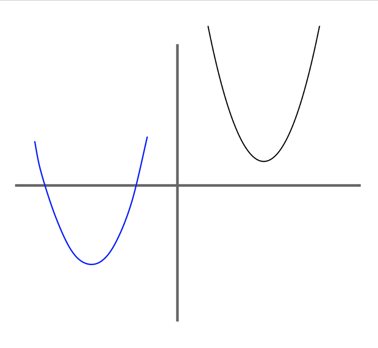
A translated function.
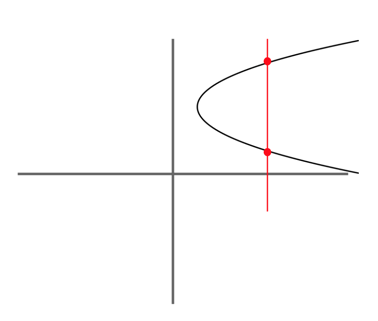
Functions cannot be rotated! This fails the vertical line test and so is no longer a function.
Function Translations
We can either translate our function vertically (up and down) or horizontally (left and right), or a combination of the two. The way we do this is by modifying our inputs and outputs (for more on how functions work, including inputs and outputs, check out our guide to SAT functions.)
We can translate our function up or down by adding or subtracting from our output.
- Adding to output translates the graph up.
- Subtracting from the output moves the graph down.
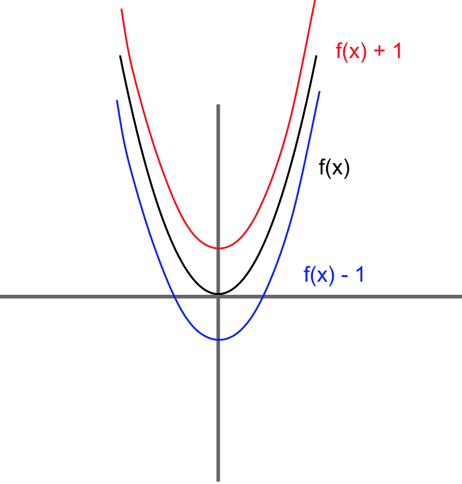
On the other hand:
- Adding to the input will shift the graph left
- Subtracting from the input will shift the graph to the right
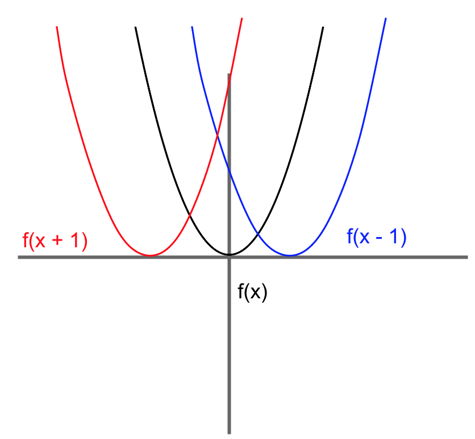
Function Reflections
We can also reflect our function about a line of symmetry along the $x$ or $y$-axis.
Making the output negative makes the function reflect across the $\bi x$-axis (inverts it about the $x$-axis).
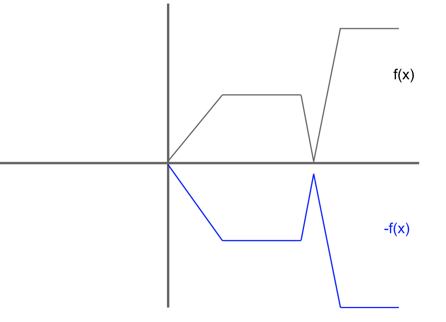
Making the input negative makes the function reflect across the $\bi y$-axis.
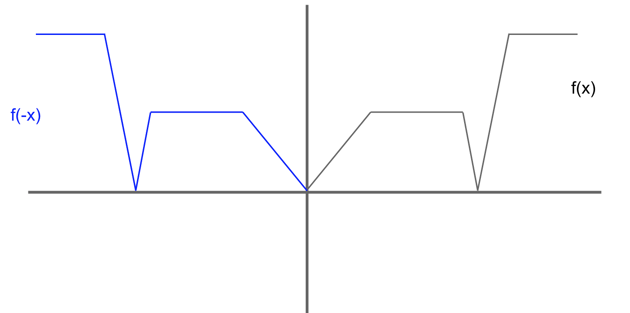

If this is a lot of new information for you, don't stress. These types of questions are, again, so rare that the odds are you won't see them on your test. Only try to memorize these rules if you feel comfortable doing so.
Strategies for Reflection and Translation Problems
Though no two reflection/translation/rotation problems are exactly alike, there are a few tips and tricks to follow for any kind you may come across.
#1: Draw Your Own Graphs
Especially when dealing with a problem that requires a reflection or a translation, it is always a good idea to take a moment to sketch out a graph of the object's old and new positions in space.
This allows you to work with the problem on the page instead of in your head, which is especially useful if you are asked to find information other than simply identifying a new coordinate point (a feat in and of itself!). For instance, you might be asked to find the slope of a reflected line, or the product of two translated $x$-coordinates, or anything else the SAT might think of.
Without making your own drawings and diagrams, it can be easy to become confused, fall for bait answers, and lose precious points.
#2: Drill Your Rotation Formulas
When working with translations or reflections, it is simple enough to draw your own picture and line up your corresponding points, but when it comes to rotations, it can be much harder to visualize the movement of the point or the object. Even when you've mapped out the original point, rotations are often much trickier than they appear.
Unless you have a paper cut-out of your point, shape, or function and want to spend your time spinning your scratch paper around in circles, it's better to simply memorize your rotation rules for 90, 180, and 270 degrees.
#3: Double-check, double-check, (triple-check)
Rotations, reflections, and translations may seem simple (and, indeed, the underlying principles are not overly complex), but the difficulty in solving these kinds of problems is in just how easy it is to mis-map a coordinate point or two.
Nothing is more frustrating than when you know how to solve a problem, but go too quickly or too carelessly and so get the question wrong. So make sure you double-check that you've properly shifted your coordinates before you bubble in that final answer.
Test Your Knowledge
1.
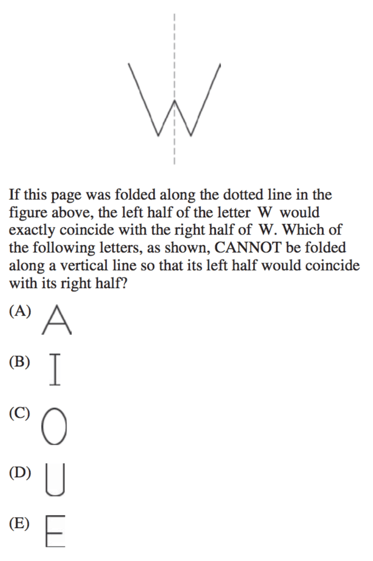
2. The graph $y = f(x)$ is shown below.
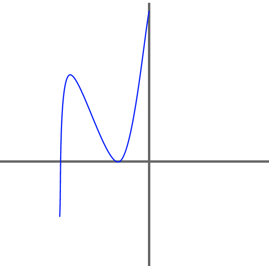
What could be the graph of $y = f(x + 3)$?
A.

B.
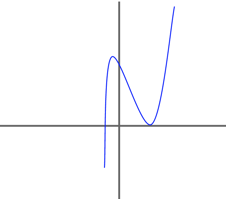
C.
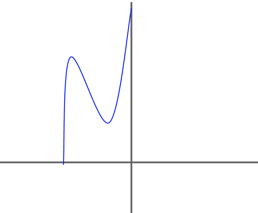
D.
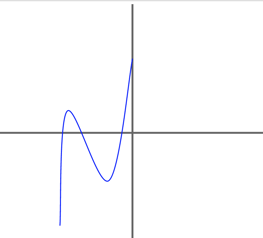
E.
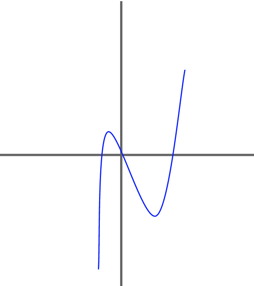
Answers: E, A
Answer Explanations:
1. If we draw an imaginary vertical line through every letter in the answer options, we can see that all but one are symmetrical about that vertical line.
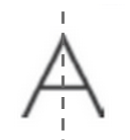

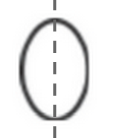
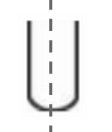

Only the letter E has a different shape to it on each side of the vertical line.
Our final answer is E.
2. We know that adding to the input or output will shift our graph and translate it somewhere else. In this case, we are adding to the input, which, you'll recall, translates our graph to the left. We are making no additional changes, so its vertical position will remain unchanged.
The only answer choice that shows us a graph that maintains the vertical position and is shifted to the left is answer choice A.
Here is the starting position of the function.

And here it is shifted to the left in answer choice A.

Our final answer is A.

Yay! You did it!
The Take-Aways
Though quite rare to see, the surprise rotation or reflection question can throw a wrench in the works if you are unprepared for it. But nothing the SAT can put on the test is insurmountable (and, indeed, the test is designed to give you opportunities to succeed).
Once you've got your understandings down tight and know not only the difference between all your terms, but how to properly take down any kind of coordinate geometry question the SAT can throw at you, you will be well on your way to earning that perfect score.
What's Next?
You've taken on one of the more obscure SAT math topics, but have you made sure that you have a solid understanding of all the rest of the math topics the SAT will test you on? As always, it is better to get as many points as possible (as accurately as possible), so now might be a good time to catch up on your understanding of circles, triangles, and integers, both basic and advanced.
Want to know two of the most invaluable math strategies? Check out our guides on how to use plugging in numbers and plugging in answers to make sense of some of the trickiest SAT problems out there.
Looking to get that perfect score? Our team has your back with our guide to getting a perfect 800 on the SAT math, written by a perfect-scorer.
Ready to go beyond just reading about the SAT? Then you'll love the free five-day trial for our SAT Complete Prep program. Designed and written by PrepScholar SAT experts, our SAT program customizes to your skill level in over 40 subskills so that you can focus your studying on what will get you the biggest score gains.
Click on the button below to try it out!
Have friends who also need help with test prep? Share this article!

Courtney scored in the 99th percentile on the SAT in high school and went on to graduate from Stanford University with a degree in Cultural and Social Anthropology. She is passionate about bringing education and the tools to succeed to students from all backgrounds and walks of life, as she believes open education is one of the great societal equalizers. She has years of tutoring experience and writes creative works in her free time.


































 Holly R.
Holly R.